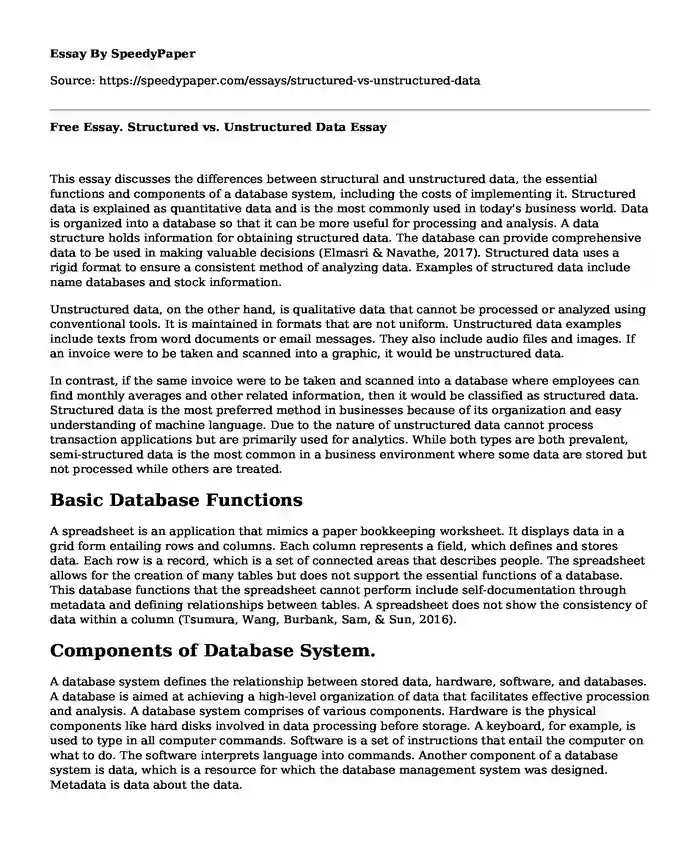
| Type of paper: | Essay |
| Categories: | Business Data analysis Software |
| Pages: | 3 |
| Wordcount: | 780 words |
This essay discusses the differences between structural and unstructured data, the essential functions and components of a database system, including the costs of implementing it. Structured data is explained as quantitative data and is the most commonly used in today's business world. Data is organized into a database so that it can be more useful for processing and analysis. A data structure holds information for obtaining structured data. The database can provide comprehensive data to be used in making valuable decisions (Elmasri & Navathe, 2017). Structured data uses a rigid format to ensure a consistent method of analyzing data. Examples of structured data include name databases and stock information.
Unstructured data, on the other hand, is qualitative data that cannot be processed or analyzed using conventional tools. It is maintained in formats that are not uniform. Unstructured data examples include texts from word documents or email messages. They also include audio files and images. If an invoice were to be taken and scanned into a graphic, it would be unstructured data.
In contrast, if the same invoice were to be taken and scanned into a database where employees can find monthly averages and other related information, then it would be classified as structured data. Structured data is the most preferred method in businesses because of its organization and easy understanding of machine language. Due to the nature of unstructured data cannot process transaction applications but are primarily used for analytics. While both types are both prevalent, semi-structured data is the most common in a business environment where some data are stored but not processed while others are treated.
Basic Database Functions
A spreadsheet is an application that mimics a paper bookkeeping worksheet. It displays data in a grid form entailing rows and columns. Each column represents a field, which defines and stores data. Each row is a record, which is a set of connected areas that describes people. The spreadsheet allows for the creation of many tables but does not support the essential functions of a database. This database functions that the spreadsheet cannot perform include self-documentation through metadata and defining relationships between tables. A spreadsheet does not show the consistency of data within a column (Tsumura, Wang, Burbank, Sam, & Sun, 2016).
Components of Database System.
A database system defines the relationship between stored data, hardware, software, and databases. A database is aimed at achieving a high-level organization of data that facilitates effective procession and analysis. A database system comprises of various components. Hardware is the physical components like hard disks involved in data processing before storage. A keyboard, for example, is used to type in all computer commands. Software is a set of instructions that entail the computer on what to do. The software interprets language into commands. Another component of a database system is data, which is a resource for which the database management system was designed. Metadata is data about the data.
An example is when a name is stored in a database; the database system will save the size of the name and the time of data storage. Procedures refer to instructions on how to use a database, which includes format and installation procedures ( Coronel & Morris, 2016). Database access language is intended to write commands and access stored data. Users include database administrators, software managers, and end-users.
An organization seeking to implement a database system could incur the charges of acquisition and operation. Database systems require well-structured hardware and software together with personnel to manage it hence high costs of maintenance. It could also cause an increase in management complexity due to increased resource requirements. Implementing a database system would force an organization to depend on venders who would charge high prices for their services (Coronel & Morris, 2016). Hardware and software become obsolete from time to time. An organization needs to come up with trends to ensure that its technology does not become outdated, which may require additional training of personnel hence high costs.
Conclusion
A database system is advantageous in various ways, including improving data security and sharing. It enables an organization to make better decisions and maintain a consistency of data. A database system can, however, lead to increased costs of acquisition and implementation. A business seeking to implement a database system should put into consideration all the advantages and disadvantages. While structural data is the most preferred in a business environment, both are used in an organization.
References
Coronel, C., & Morris, S. (2016). Database systems: design, implementation, & management. Cengage Learning.
Elmasri, R., & Navathe, S. (2017). Fundamentals of database systems. Pearson.
Tsumura, M., Wang, Y., Burbank, J., Sam, J., & Sun, G. (2016). U.S. Patent No. 9,299,041. Washington, DC: U.S. Patent and Trademark Office.
Cite this page
Free Essay. Structured vs. Unstructured Data. (2023, Mar 21). Retrieved from https://speedypaper.com/essays/structured-vs-unstructured-data
Request Removal
If you are the original author of this essay and no longer wish to have it published on the SpeedyPaper website, please click below to request its removal:
- Cultural Geography Essay Sample
- Free Essay about Computer Learning Program in Benton High
- Teachings from the Life of a Master and His Disciple, Movie Review Essay Sample
- Free Essay Exploring the Influence of Songs to the Civil Right Movement
- Research Proposal Paper Sample: Trafficking for Organ Trade
- Paper Example. Stakeholder Management Concept
- Essay Sample on Forensic Procedures to Collect Forensic Evidence from Digital Devices
Popular categories




